What is the difference between millet and millet
Millet dishes are present in the daily diet of many people. The high content of nutrients in it makes the cereal healthy. Along with millet, it is widely used in traditional medicine recipes. To find out which grains are healthier, you should know how they differ from each other.
In the article we will look at how millet differs from millet, and whether they are the same thing or not.
Chemical composition, microelements, calorie content of millet and millet
Prosom is a cereal crop from which millet is obtained by grinding the grains.
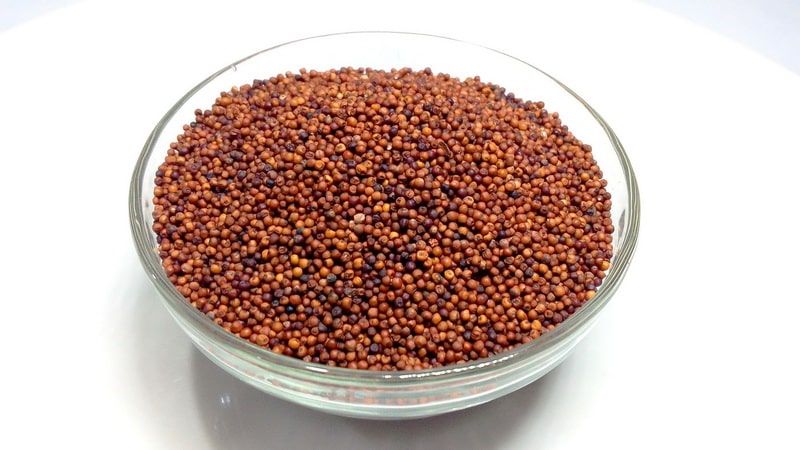
The chemical composition of the grains is similar to the composition of millet. The difference between them is the different percentage of nutrients.
Millet and millet grains are rich in vitamins (thiamine, riboflavin, tocopherol, nicotinic acid, carotene). They have a high content of microelements: calcium, magnesium, zinc, phosphorus, iodine, copper, iron and nickel. They are rich in proteins, carbohydrates, rapidly oxidizing fats, and fiber. Contain starch.
High in calories: in 100 g of millet the figure is 348 kcal, in 100 g of millet - 311 kcal.
Table. Comparison of the energy value and composition of millet and millet
| Contents per 100 g of product | Millet | Millet |
| Proteins, g | 11,20 | 11,50 |
| Fats, g | 3,90 | 3,30 |
| Carbohydrates, g | 56,60 | 66,50 |
| Vitamins | ||
| A, mg | 0,00 | 0,03 |
| B1, mg | 0,32 | 0,42 |
| B2, mg | 0,07 | 0,04 |
| PP, mg | 2,85 | 1,55 |
| Carotene, mg | 0,01 | 0,02 |
| Minerals | ||
| Sodium, mg | 28,00 | 10,00 |
| Potassium, mg | 328,00 | 221,00 |
| Calcium, mg | 51,00 | 27,00 |
| Magnesium, mg | 130,00 | 83,00 |
| Phosphorus, mg | 320,00 | 233,00 |
| Iron, mg | 3,50 | 2,70 |
Useful and healing properties of millet and millet
Millet and wheat are equally valuable products.Unprocessed and polished grains, due to their rich composition, are healthy. They are used in beauty recipes and folk medicine, in medicinal diets.
How it affects the body
Dishes based on this cereal are recommended for those who are struggling with excess weight. Millet contains substances that prevent fats from being absorbed. The product is gluten-free and hypoallergenic.
It is advisable for people on a diet to drink water infused with millet grains to reduce appetite and remove excess fluid from tissues.
Important! Doctors prescribe millet porridge to patients who have suffered a long and serious illness. She is regaining her strength. Its use ensures the removal of toxins and antibiotic residues from the body.
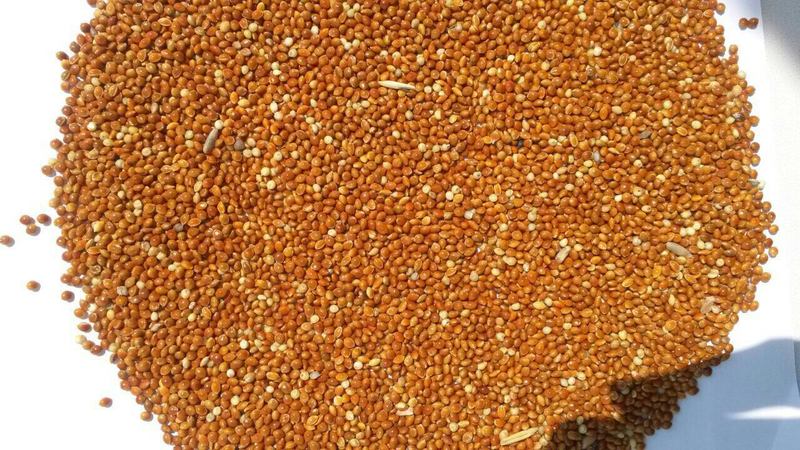
Consumption of millet porridge, sprouted millet grains or cereal-based decoctions contributes to:
- strengthening the immune system;
- better digestive processes;
- reducing cholesterol levels;
- elimination of edema;
- healing of damaged bones;
- tissue restoration and rapid wound healing;
- gaining muscle mass in athletes;
- increasing the level of hemoglobin in the blood due to the high content of iron in the grains;
- lowering blood sugar levels;
- improving the condition of hair and getting rid of the problem of dandruff due to the B vitamins contained in the product;
- strengthening the nervous system;
- improving brain function for people whose work involves high mental stress.
Millet is used in cosmetic face masks. It gives a rejuvenating effect, nourishes and restores the skin.
Doctors recommend that pregnant women and nursing mothers consume millet porridge.
The beneficial substances contained in cereal have a beneficial effect on the body:
- zinc has an antifungal effect, preserves the health and beauty of skin and hair;
- iron ensures the normal course of hematopoietic processes;
- thanks to phosphorus, the musculoskeletal system is strengthened;
- the presence of selenium provides an anti-cancer effect and a rejuvenating effect;
- tocopherol is necessary to strengthen the immune system;
- due to the sodium content in the porridge, the work of the salivary and pancreas glands is stimulated, and the production of gastric juice improves;
- Thanks to fluorine and silicon, good condition of teeth, nails, skin, and hair is ensured.
Medicinal properties for various diseases

Due to their rich composition, millet and millet grains are used in the fight against many diseases:
- in case of endocrine disruption, it is recommended to eat fresh, unprocessed millet;
- porridge helps fight heart pathologies due to its high potassium content;
- for kidney diseases, millet is used as a strong diuretic;
- recipes using millet and millet are recommended for people suffering from diabetes, pancreatitis, cholelithiasis, liver pathologies, and metabolic disorders;
- millet decoctions have a positive effect in the fight against diseases of the genitourinary system;
- millet helps fight colds and runny nose;
- Traditional healers recommend recipes using raw millet for people suffering from cancer.
What is the difference between millet and millet
Significant difference between millet and millet No. These are the grains of one cereal plant. The difference is that millet grains have been processed by grinding to become a grain, while millet grains are unprocessed.
Main Differences
You can distinguish millet from millet by appearance.
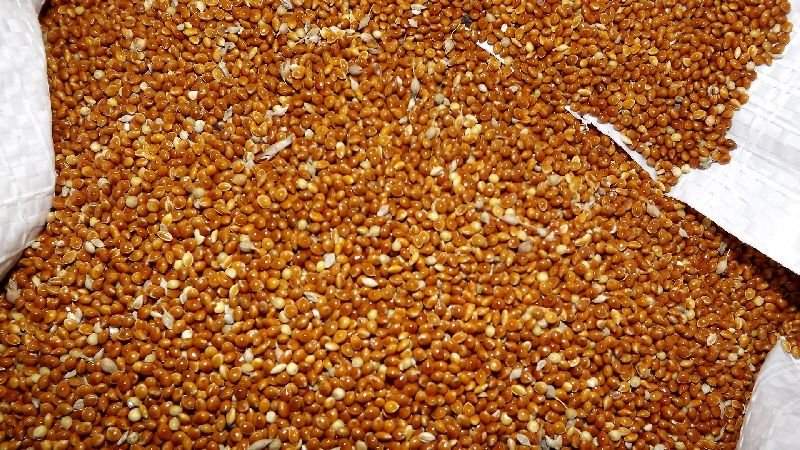
Millet grains are whole, covered with a film. They come in white, red and yellow colors, depending on the type of cereal. White or red grains are used for food purposes. They are processed into cereals and used to produce malt. The yellow grains are used as food for birds and animals.
Reference. The brighter the color, the more nutrients millet contains. The most productive and high-quality cereal is considered to be of a reddish hue.
Millet is a cereal consisting of polished millet grains. There are several types of it, differing in production technology:
- Dranets. The most useful millet cereal, consisting of grains devoid of colored films. They are smooth and shiny, with a bitter aftertaste.
- Sanded cereal, yellow and matte. The variety is the most common. Used for preparing various dishes.
- Crushed millet cereal, consisting of yellow ground grain crushed into small particles. It differs in that during cooking it boils stronger and faster.
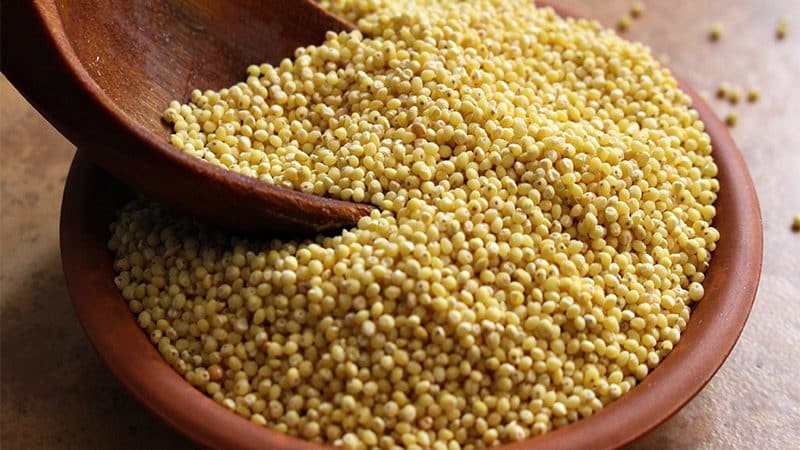
Differences in beneficial properties
Millet and millet have similar beneficial properties. But grain that is not devoid of all shells has a 1.3-2 times higher content of minerals (sodium, magnesium, potassium, calcium, phosphorus, iron), riboflavin and nicotinic acid than polished grains.
Millet has a higher calorie content. It contains more carotene and thiamine. It is better absorbed by the body than film-coated grains.
How to use - folk recipes
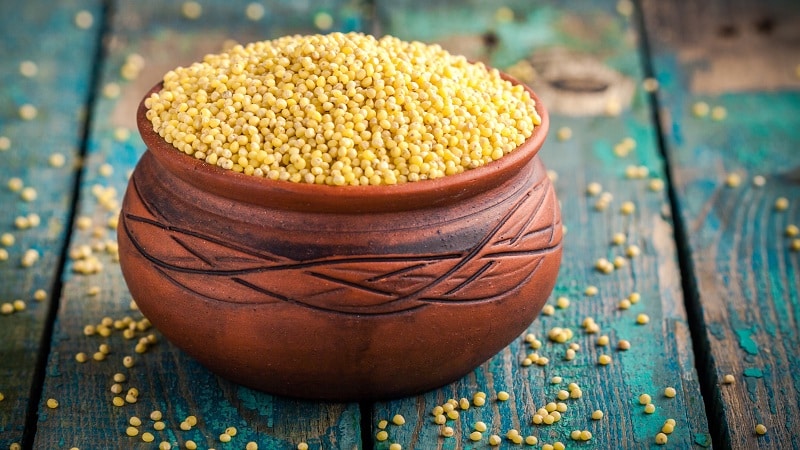
Traditional medicine offers many effective recipes based on millet and millet that help fight various diseases:
- For diabetes Millet flour is recommended. It is taken once every 7 days, one tablespoon.Flour is prepared by grinding cereals in a coffee grinder. Do this immediately before using the product internally.
- Hypertensive patients A remedy prepared from one teaspoon of millet flour and 300 g of cool water will help. It is drunk on an empty stomach during the day, divided into 3 doses.
- Patients with pancreatitis you should eat millet porridge. To prepare it, boil one glass of cereal in 2 liters of water. When the grains are boiled, add grated pumpkin and a little vegetable oil. Boil for a few more minutes and add moderate salt. The course of treatment is 1 month. During this period you will need to give up dairy.
- Get rid of cystitis Millet water will help. It is prepared by pouring ½ cup of millet into 1 liter of cool water. The wet cereal is crushed with your fingers until a whitish precipitate is obtained. The resulting water is drunk without restrictions. It relieves pain. The course of treatment is at least two weeks.
- Fight sinusitis In particular, with frontal sinusitis, warming with hot millet will help. But at the stage of exacerbation of the disease, when there is a high temperature and purulent discharge, the recipe cannot be used. It is used to warm the maxillary sinuses when the first symptoms appear. The hot grain is placed in flannel bags and applied to the sore spot. The procedure is carried out before bedtime.
- For pain in the heart Porridge made from fried millet will help. It is prepared like this: ½ cup of cereal is fried in a frying pan until brownish. Then porridge is cooked from millet. It is eaten warm during the day.
- To get rid of a runny nose inhale the smoke that is produced when millet is burned.
- Fight bedsores You can by placing bags of millet under a bedridden patient.
Harm and contraindications
The benefits of consuming millet and millet are undeniable. But you shouldn’t overuse them - there is a risk of complications. Excessive consumption of millet porridges threatens:
- disruption of the digestive process;
- deterioration of health in patients suffering from acute diseases affecting the gastrointestinal tract.
It is not recommended for men to get carried away with dishes based on millet and millet porridge - this can lead to a decrease in potency.
Who should not eat millet and millet?
Experts insist that dishes prepared with millet cereals are considered heavy food. Millet should be consumed with caution by people suffering from various pathologies of the gastrointestinal tract. You should not overuse millet dishes if you have diagnosed problems with the endocrine system.
Cereals contain substances that interfere with the absorption of iodine by the thyroid gland. Scientists have different opinions on this matter: some experts claim that this property of millet is leveled out during heat treatment, others think differently.
Eating millet by people with high stomach acidity can cause heartburn. Elderly people should use millet with caution - the product can cause constipation in them.
A millet diet is not recommended for patients diagnosed with hyperacid gastritis, hypothyroidism or gastric ulcer.
Read also:
Calorie content and beneficial properties of brown rice for the human body.
We use pumpkin correctly for weight loss.
Does corn contain gluten, is it present in corn grits and flour, and why is it so dangerous?
Conclusion
Now you know the difference between peeled and unpeeled millet and what their beneficial properties are. Millet is an ancient grain crop.Millet groats are produced from it. The cereal itself, like cereals, is applicable not only in cooking.
Due to its valuable composition and beneficial properties, it is used in folk medicine and cosmetology. Don't forget about contraindications and stay healthy.